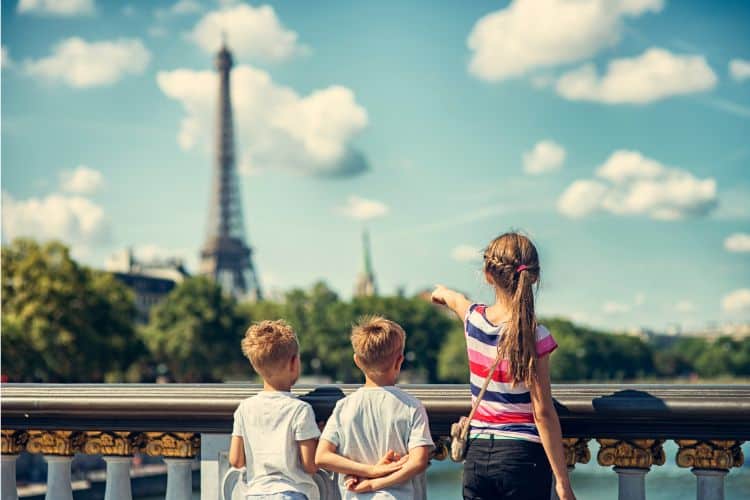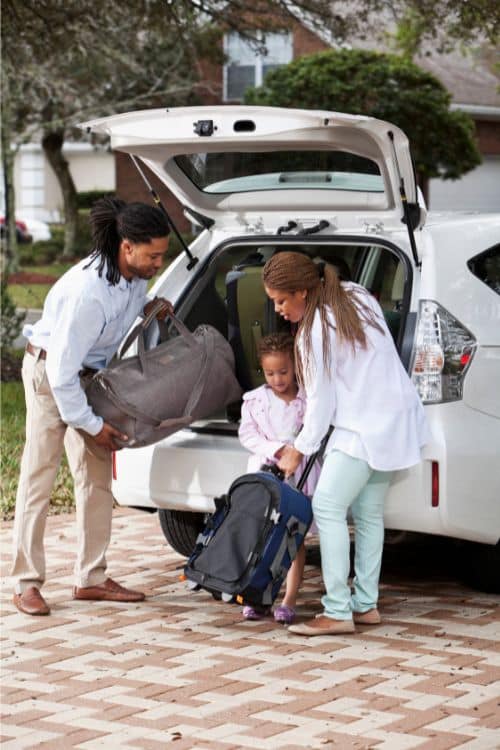INTRODUCTION
In the first part of our conversation with Carl Honoré, we explored the philosophy of slow travel and how it encourages us to savor every moment of our journeys.
In this post, we discuss Carl’s children’s book, Slow Adventures: Enjoy Every Moment: 40 Real-Life Journeys by Boat, Bike, Foot, and Train (published in the UK as It’s the Journey, Not the Destination).
This beautifully illustrated book invites families, especially children, to experience travel in a more mindful and immersive way. It encourages young readers to slow down, look closer, and truly wonder about the world around them.
Carl shares the inspiration behind the book, the creative choices that make it unique, and practical advice for embracing slow adventures. We also explore how the book is structured around journeys by foot, bike, boat, and train, and what Carl hopes families will take away from reading it together.
HELPING CHILDREN DISCOVER THE JOY OF SLOW TRAVEL: Q&A WITH CARL HONORE ABOUT HIS BOOK SLOW ADVENTURES
Note: The following responses have been edited for brevity while preserving their original intent.
1) SLOW ADVENTURES: WHAT IS THE BOOK ABOUT AND WHO IS IT FOR?
I’d like to switch from talking about slow travel in general to talking about your book Slow Adventures: Enjoy Every Moment: 40 Real-Life Journeys by Boat, Bike, Foot, and Train. Can you give us an overview of Slow Adventures, who the book is for and what it’s about?
Slow Adventures is written as a children’s book. And actually, Slow Adventures is the US title. In the UK, the title is It’s the Journey, not the Destination.
In a nutshell, it’s about slow travel, and the joy and wonder of moving through the world at a slower pace. It contains 40 journeys, divided into four pillars: travel by foot, by bike, by boat, or by train, all around the world. The idea is that children and their parents can explore together as they read about each one.
Families are particularly well-equipped for slow travel because, as anyone who’s had small children knows, kids don’t do tight schedules very well. They’re masters of slowness. They can just disappear into the moment and forget what time it is. They just get on with savoring and exploring and playing and having fun. All the stuff that travel is supposed to be about.

The book is a kind of clarion call saying, “We’ve lost the art of travel, let’s get it back. And the way to do that is to bring this slow mindset into the equation.”

I wanted it to be a book that people could take off the shelf and say, “Okay, where are we going to go tonight?” And then maybe just read about one place, like a bedtime story.
And now that the book’s been out for a bit, I hear that’s how a lot of parents use it. They throw it open and it becomes a place they can visit with their kids. They kind of disappear into it.
That reflects my experience of writing it. I wrote it during the pandemic when I couldn’t travel anywhere.
So it was a godsend and a real luxury, when I couldn’t go anywhere, to be able to travel around the world in my own imagination, on a magic carpet of words.
And that’s what I wanted to bring to the reader. Because the expectation is not for people to go to all of these destinations. I haven’t. And if everybody who read Slow Adventures went to every single one of those destinations, that would be too much tourism.
We’re back to the ethical dilemma of how much travel is too much? The reality is that people aren’t going to visit every destination in the book. But they can get a flavor of what being there is like by reading about it.
It’s a flight of fancy. Because that’s what bedtime stories are meant to be. You and your child go on a journey of imagination into a fantasy land. That’s what I wanted to create with the book, but anchored in real places. So it’s very well fact-checked and researched. It’s all very accurate. And I have heard that some people are using it as an ideas book. They’re looking at it and saying, “We’ve got a big trip this year. Why don’t we go to this place?”
2) WHY A TRAVEL BOOK FOR CHILDREN?
What was the impetus behind the book? What inspired you to write it, and why a children’s book?
I’ve always written for adults, but as someone who’s interested in words and language, I wanted to play around with different forms. And I’d always had the idea of writing a children’s book. I just wasn’t quite sure which way to go with it. Because of the pandemic, I was thinking “If we can’t leave our homes, how do we learn about the world?” So I was kind of playing with that idea of “How can we travel in our imagination?”
Then I was approached by a publisher who was interested in doing something on slow travel, and it all came together instantly, pretty much. It seemed clear how to structure it. Because, the basic idea of the UK title, It’s the Journey, not the Destination, is built into the whole framework, with the four pillars of the journeys.
The architecture of the book is suggesting to the reader, “This is not a prefab experience you pull off the shelf. It is all about the journey.”
And I think that outlook is one of the things we sacrifice on the altar of speed. We’re so obsessed with getting to the destination, with the outcome, final numbers, metrics. It’s all about “show me the numbers.” It’s all algorithmic, and that’s so joyless.
Obviously, we need output. We need the things that happen at the end to be the outcomes we want. But we also need to preserve the art of the journey, the joy of process. Because there’s so much, not only to enjoy and savor, but to learn along the way. And I feel like travel is a good way to introduce children to that idea.
So it’s a book about travel, but it’s introducing the broader idea and principles of the slow mindset to families and children, through the lens of travel.
3) ILLUSTRATING THE JOURNEYS: WHY DRAWINGS, NOT PHOTOGRAPHS?
Let’s talk about the illustrations, because the book is beautifully illustrated.
Thank you. They’re not my drawings. I sketch as a sort of ritual, but my drawings are certainly not good enough to grace a children’s book. It’s a very talented young couple who illustrated it.
This was my first children’s book. So how you choose the illustrations was very new to me. When I was talking to the publisher, they said, “Don’t worry, we’ll find the right illustrator.” And they did. The couple who ended up illustrating the book was the third candidate we tried. And it’s funny, both my publisher and I immediately thought, “This is exactly what we had in mind.” Even though we hadn’t quite put it into words. It was a nice experience to open up the PDF and think, “yeah, this is what we’ve been looking for.”
The illustrations have got a slight vintage vibe to them, but at the same time, it all feels modern and fresh. It felt like a gentle nod to the golden age of travel, when it was an elegant, sophisticated, unhurried experience. But it didn’t feel like the illustrations had been drawn in that era. The book is a wink in that direction, but at the same time, it has its feet firmly in the 21st century.
Often with travel, books are illustrated with photos, and here you’ve chosen drawings. Can you tell me a little about that choice?
Whether or not to use photos did come up, as these are real places. We made the choice to use drawings for two reasons: One, the publisher tends to use drawings. And two: I thought it was pretty clear that using photos was completely against the spirit of the slow mindset.
Because photos would crystalize one vision of the place in the reader’s mind. And it goes back to that argument against homogenization I was making earlier. To use photos would effectively be telling the reader “If you went to this place, this is what you would see.”
I didn’t want that. I wanted children, when they open the book to a journey, to imagine in their own head what that place looks like.
Drawings help with that. They give someone else’s version of that place. But because they’re not photos, they’re just more fodder for the imagination, so the child can draw their own picture in their mind. Parents, too, for that matter.
Yes, that definitely comes through. It probably wouldn’t have occurred to me to use drawings instead of photos for a travel book. But once I saw it, I could imagine, from a child’s point of view, opening this book and seeing the drawing, then creating a vision of that place in their own head.
So let’s say they read about the journey to Costa Rica, for example, and they get to build up a vision of what it’s like there in their heads. If their family then travels there, the child gets to have that sense of wonder when they see it for the first time with their own eyes.
Exactly. You put your finger on a really important word there: wonder. Which I think is something that gets completely lost in this “fast-forward, read all the Yelp reviews” culture.
This is another dividing line between fast travel and slow travel. So much of fast travel is about planning. Let’s keep Costa Rica as an example. You say “Let’s go to Costa Rica.” What do you do? You get on TripAdvisor, you read the reviews, you watch a bunch of travel vlogs. And when you finally get there, it can be a little anticlimactic. Because you’ve basically already seen some version of everything you’re going to see.
By doing that, you’re denying yourself the transcendent joy of stumbling over small miracles. So much of the wonder of travel comes from the element of surprise. If you’ve already traveled virtually through a place before you even get there, where is the space for serendipity? Instead of surrendering to serendipity, instead of going down a path just because we’re curious and it looks interesting, we end up looking at our checklist and saying, “We’ve got to go to XYZ restaurant because it has 4.9 stars.” And we just go straight there. We have tunnel vision. So we miss what’s on the periphery.
Slow travel is the opposite of that. It’s about curiosity and discovery. With a slow mindset, you’re much more likely to say “Okay, let’s go have dinner. That area over there seems interesting. Let’s browse around and see what catches our fancy.”
4) THE FOUR PILLARS OF SLOW ADVENTURES: JOURNEYS BY FOOT, BIKE, BOAT AND TRAIN
We touched briefly on the fact that you have divided the journeys in Slow Adventures into four pillars: by foot, by bike, by boat and by train. Can you tell me a little bit more about why?
It’s probably best to discuss that in two stages. One is the decision to remove planes, which I think we covered when we discussed all the harm and sadness of plane travel. So it was an easy decision not to include plane travel in the book.
The second question, which some people might find more problematic, is the decision not to include journeys by car. Because it is possible to do slow travel by car. I sometimes travel by car. If I’m staying in rural Italy, for example, it’s really hard to get around on a bus. You need a car to get to places.
But I wanted to keep it to four pillars, and it felt to me like the car can be problematic. Whereas the other ones are much less so. Travelling by foot, bike, boat, or train is generally always slow. Car travel can be slow if applied properly, but often it’s not.

For a start, car travel is very isolating. You’re in the car by yourself, or with your own crew. It’s not like being on a train or boat with other people, so that opportunity for connection is cut.
Very often in a car, you’re on a motorway or a highway. Which is built for cars. There’s nothing to look at. It’s incredibly dull, and it’s just about speed. You’re not trying to enjoy that journey. You’re just trying to get through it as quickly and safely as possible. And that just seemed to me to run against the whole spirit of the book.
Whereas when traveling by train or by boat, there is much more of a sense of place.
And in terms of carbon footprint per kilometer traveled, cars are in the bad boy club, compared to any of the other four.
So the case against cars as a form of slow travel is compelling enough that it wasn’t a hard decision to excise them from the equation.
5) CURATING THE JOURNEYS: HOW CARL CHOSE THE 40 DESTINATIONS
And within those four pillars, the book contains 40 journeys. How did you narrow it down to those particular journeys?
Oh, that was difficult. It was fun, but difficult, because there’s a thousand journeys you could choose. So it was a big triage job.
I started with the journeys that I had done myself. So that was easy enough. I can’t remember off the top of my head how many of those there were, but it was a fair number of them.
Then I began putting out feelers on social media to friends and such, and people would say, “Oh, you’ve got to include this one and that one.” And then pretty quickly, I just sort of built up a database of potential trips. Then I began doing some research on them, and for a lot of them, once I scraped away at the surface, I began to think, “Hmm, this is not hitting all the boxes.” Or “It’s not as slow as it seems on the face of it.”
The other thing is that I didn’t want the journeys to be too similar. And I wanted to cover a wide sweep of the world as well.
By the end, I had whittled it down to the 40 journeys I included. And I don’t feel like “Oh, I left three out that I was desperate to get in.” The 40 I ended up with felt like a good tight 40.
6) WHAT FAMILIES CAN GAIN FROM READING SLOW ADVENTURES TOGETHER
Final question: What do you hope families take away from reading Slow Adventures with their kids?
I suppose just the very simple message that the world is a far more thrilling and beautiful place if you move through it slowly. Slow travel is a wonderful way for children to learn the power and the beauty of slowness as a way of being. And it’s also a great way to bring families together, and to forge memories that last a lifetime.

7) THREE TIPS FROM CARL ON EMBRACING SLOW TRAVEL
At the end of Slow Adventures, Carl gives helpful advice in a section called “12 Ways to Travel ‘Slow’”.
Below are three tips from that list, to help you embrace a more mindful, unhurried approach to travel, which Carl has graciously offered to let us share here:
- Do things for the joy of it
Casting off the pressure to tick boxes is a blissful release. Dawdle in the pool. Daydream in the shade when the sun is high in the sky. Doodle on the back of a napkin. Read another chapter of that book you can’t put down. Enjoy the sweet thrill of sometimes doing nothing at all!
- Embrace serendipity
The richest experiences are often unplanned and unscripted. Keep a light schedule. Wallow in accidental pleasures. Stumble on a big thought or a small detail. Indulge a whim. Slip into a delicious siesta after lunch.
- Tread lightly on the planet
Travelling can go hand in hand with protecting Mother Nature. Use forms of transport that are kinder to the planet. Buy local. Consume wisely. Treat the places you visit as you would like others to treat your home.
About Carl Honoré

Carl Honoré is an author, speaker, and renowned advocate of the Slow Movement, a global effort to help people live and travel more mindfully.
His bestselling book In Praise of Slow explores the societal obsession with speed and how slowing down can lead to a better life.
Carl’s insights have also reached a broad audience through his TED Talks “In Praise of Slowness” and “Why We Should Embrace Aging as an Adventure.” These talks further explore the value of slowing down in various aspects of life.
Carl has written several books for adults and children, encouraging readers to rethink their pace and connect more deeply with the world around them.
His latest children’s book, Slow Adventures: Enjoy Every Moment (published as It’s the Journey Not the Destination in the UK) invites young readers to discover the joy of slow travel.
Carl believes travel should be meaningful, not rushed, and that slowing down helps us care more for the planet and for ourselves. His work continues to inspire individuals to reconsider the pace at which they live and travel.




